|
FOCUS
ON DANIEL - LESSON 5
Right
Wins
Daniel 8
During the closing
days of World War II, Dietrich Bonhoeffer, a young German theologian,
was escorted from his cell in a Nazi concentration camp and hanged for
the crime of high treason. At the time it seemed that Hitler's madness
had mesmerized all of Germany. Very few people raised voices of protest
against what was happening in Nazi Germany. But Bonhoeffer had not been
able to bow before the swastika. He had helped to organize a group of
believers into the Confessing Church that preached the lordship of Jesus
Christ and His truth at a time when Nazi dogma seemed to be the only truth.
Because he plotted against Hitler, Bonhoeffer was sentenced to death.
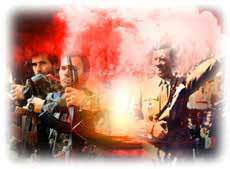 Decades
later, in 1996, Germany had become a very different country. Germans
were trying to confront Hitler's horrors and make amends for the terrible
suffering the Nazis had caused. That year, a court in Berlin officially
declared Dietrich Bonhoeffer innocent of the charge of high treason.
He had not betrayed his country. Rather, he had taken a costly stand
for justice. Decades
later, in 1996, Germany had become a very different country. Germans
were trying to confront Hitler's horrors and make amends for the terrible
suffering the Nazis had caused. That year, a court in Berlin officially
declared Dietrich Bonhoeffer innocent of the charge of high treason.
He had not betrayed his country. Rather, he had taken a costly stand
for justice.
Daniel chapters 8
and 9 present a similar dramatic story—one that plays out on a very
large scale. Satan has tried to mesmerize the whole world and keep it
under his control. He is the accuser who constantly attacks God's character
and His people. He is the father of lies. But God keeps telling the truth;
He keeps working for peace and justice. And someday the whole universe
is going to celebrate the triumph of God's truth in this world.
Do you sometimes feel
that you're under attack? Does it seem that life is not treating you fairly?
Maybe your marriage is causing you a lot of pain. Maybe it's a constant
worry about finances—just when you think you have a little saved,
the car quits running or the refrigerator breaks down. Maybe you can't
seem to get ahead at work—someone else always gets the promotion.
The Bible wants you to know that there's good news. Whatever injustices
we may have to bear now, God's truth is going to triumph in the end. No
act of mercy will go unrewarded; no deed of kindness will be forgotten.
You can come out in the winners' circle if you just stick close to God.
Daniel 8 and 9 are your chapters, written to prove that God is
on your side.
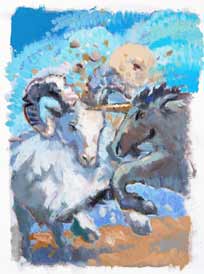 Daniel
2 showed us broad outlines of the kingdoms which would dominate world
history. Daniel 7 presented the same outline with different symbols.
But it also highlighted how God's people would come under attack by
a power that combines church and state, a power that substitutes man's
thinking for Bible truth. In Daniel 8 we will cover some of the same
history, but as we do we will see even more details. We'll see more
of the triumph of truth as Scripture is restored, people are moved to
repentance, judgment takes place, and God's people get ready for heaven. Daniel
2 showed us broad outlines of the kingdoms which would dominate world
history. Daniel 7 presented the same outline with different symbols.
But it also highlighted how God's people would come under attack by
a power that combines church and state, a power that substitutes man's
thinking for Bible truth. In Daniel 8 we will cover some of the same
history, but as we do we will see even more details. We'll see more
of the triumph of truth as Scripture is restored, people are moved to
repentance, judgment takes place, and God's people get ready for heaven.
Chapter 8 shows us
yet another vision God gave Daniel. In vision Daniel finds himself in
the capital city of Susa, standing by the River Ulai. Looking across the
river, he sees a ram poised on the far bank. This is no ordinary animal.
Like other prophetic beasts it has interesting attributes. Two long horns
grow out from its head. One horn comes in a bit later than the other,
and it grows taller than the other. This ram is a powerful beast. It charges
north, south, and west.
As Daniel watches
in fascination, a male goat comes trotting up from the west. This goat
has a single horn between its eyes. The goat is powerful and moves like
lightning; its feet don't even touch the ground. The goat charges the
ram and breaks off both of its horns. Then he knocks the ram to the ground
and tramples the animal.
This "he-goat" (KJV)
now becomes so powerful that no other beast can defeat him. But at the
height of his power, his horn is broken off and four other horns grow
in its place. Out of one of these horns grows a "little horn"
(vs. 9). This "little horn" does several things. It:
- Expands to the
south, the east, and the glorious land (vs. 9).
- Ascends to the
host of heaven (vs. 10).
- Throws down some
of the host and stars and tramples them (vs. 10).
- Exalts itself
as high as the Prince of the host (vs. 11).
- Removes the daily
sacrifices and degrades the sanctuary (vs. 11).
- Takes over the
daily sacrifices and throws truth to the ground (vs. 12).
In his vision, Daniel
next sees two angels talking with each other. One angel asks, "How long
will the vision be, concerning the daily sacrifices and the transgression
of desolation, the giving of both the sanctuary and the host to be trampled
underfoot?" The other angel answers, "For two thousand three hundred days;
then the sanctuary shall be cleansed" (vss. 13, 14).
In other words, the
first angel has observed what the "little horn" does, especially to the
sanctuary and the sacrifices, and he wants to know how long it will be
before the desecration of God's holy place and its services will end and
things be restored to what God intended them to be. The answer is that
they will be restored after 2,300 days.
Read
Daniel 8:15-19.
1.
What did Gabriel come to do for Daniel? (Daniel 8:15, 16.)
Assure him that God knew about his troubles and would take care of him.
Help him understand the vision God had given him.
Heal him of his disease.
2.
Gabriel told Daniel that the vision was focused on: (Daniel 8:17.)
the time of the end.
the events of Jesus' life here on earth.
the kingdom of Rome and the effect it would have on God's people.
Next, the angel
gives Daniel a glimpse of events at the time of the end.
3.
What world power does the ram with two horns represent? (Daniel 8:20.)
The kingdom of Rome.
The kingdom of Greece.
The kings (or kingdoms) of the Medes and Persians.
The fact that
one horn was higher than the other symbolizes the historical reality that
Persia became the more dominating part of the Medo-Persian Empire.
4.
What world power does the male goat represent? (Daniel 8:21.)
The kingdom of Rome.
The kingdom of Greece.
The kings (or kingdoms) of the Medes and Persians.
The large horn, or
"first king," represents Alexander the Great. He died at the height of
his power, and his empire was divided among his four leading generals—Cassander,
Lysimachus, Seleucus, and Ptolemy. These four generals are the four horns
of verses 8 and 22.
5.
The prophecy says that a king would rise up following these kingdoms and
that he would: (Daniel 8:23, 24.)
destroy God's people.
bring the world to an understanding of the true God.
be utterly defeated when he makes war on neighboring kingdoms.
As we learned in Daniel
7, this "little horn" or "king" represents a combination of church and
state—the combination of pagan and papal Rome.
6.
The prophecy goes on to say that this "little horn" king would:
(Daniel 8:25.)
bring peace to the world in the last days.
act with cunning and even oppose the Prince of princes, but his power
will be broken.
involve all nations in a struggle to control the world's oil supply.
Isaiah 9:6 describes
the Messiah as the "Prince of peace." In Acts 3:15 Jesus is called the
"Prince of life." So when this earthly religious power "rise[s] against
the Prince of princes" (Daniel 8:25), it is really challenging Jesus Christ
and trying to claim equality with God. This power takes away the daily
sacrifices and casts down the sanctuary (vs. 11). The sanctuary service
was a picture lesson of the forgiveness of sin and our salvation through
Jesus, the Lamb of God. So this power is interfering with the gospel plan
of grace. But note that God gives us a word of assurance here. He tells
us that this power will be destroyed, but not by human hands. In other
words, God Himself will act decisively; a supernatural event will bring
this power down.
In verse 26 the angel
ends his explanation by referring Daniel back to the vision of the "evenings
and mornings" (an evening and morning equals one day) which we read about
in verse 14 (the 2,300 days). The angel tells Daniel that this vision
is indeed true.
7.
How did Daniel react to the vision and its explanation? (Daniel 8:27.)
He was encouraged to know that God was in control of world events.
He was humbled to think that God would confide His plans to him.
He fainted and was sick for days.
What
Is the Sanctuary?
As we've seen, the
central theme of Daniel 8 is the sanctuary and what the "little horn"
does to it. In order to understand this chapter more clearly, we need
to take a look at the sanctuary system. Studying the sanctuary will also
help us understand the explanation of the 2,300 days that is given in
Daniel 9.
Why
Was a Sanctuary Needed?
In the beginning there
was no sin in our world. That meant no one ever hurt anyone else. No one
ever suffered, got sick, or died. Unfortunately, Adam and Eve chose to
disobey God, and that opened the door to the plague of sin—and all
the suffering that results from sin. Fortunately, Adam and Eve expressed
sorrow for their sin, and right then God forgave them and promised that
some day a baby would be born who would restore all things.
Adam and Eve's descendants
eventually spread over the Earth. They forgot about God and began sinking
further and further into sin until God had to step in and stop the cruelty
and suffering with a worldwide flood.
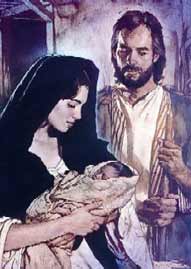 As
time went by and people once again began spreading over the whole Earth,
God wanted to demonstrate to everyone that He loved them. He wanted
to teach them about the blessings of being in a relationship with Him.
He decided He could best communicate His love through a special nation.
He planned to make the people of Israel an example to the whole world
of how wonderful it is to follow the God of heaven. As
time went by and people once again began spreading over the whole Earth,
God wanted to demonstrate to everyone that He loved them. He wanted
to teach them about the blessings of being in a relationship with Him.
He decided He could best communicate His love through a special nation.
He planned to make the people of Israel an example to the whole world
of how wonderful it is to follow the God of heaven.
In addition, God wanted
to show the world, through the Israelites, just how He planned to bring
the tragedy of sin to an end. He wanted to teach all people about grace
and forgiveness, about the hope of a Messiah, a Savior, who would one
day sacrifice Himself for human sin so that men and women could have eternal
life with God. God had a plan.
As His principal means
of teaching people all these things, God designed a sanctuary service
for Israel. All the details of that service illuminated the plan of salvation.
All the sacrifices pointed forward to the Messiah, the One who would pour
out His lifeblood in order for our sins to be forgiven. Everything that
happened in the Hebrew temple was an object lesson, a way to help human
beings visualize and experience the fact that their sins were forgiven.
God
Tells Moses How to Build the Sanctuary
Much of the book
of Exodus is taken up with the instructions God gave Moses regarding the
sanctuary and its service. In some ways the Hebrew temple was similar
to what we would call a church today. But when the Israelites gathered
for religious festivals, they didn't go inside the sanctuary; they assembled
in the courtyard outside. Only the priests went inside to present the
blood of sacrifices before God.
Exodus 25:8 tells
us God's essential purpose in having the sanctuary built: "And let them
make Me a sanctuary, that I may dwell among them" (emphasis supplied).
You see, sin caused a tragic separation between human beings and their
Creator. The sanctuary was God's way of showing how He can again live
among us. Its ceremonies reveal how God communicates with us and how we
can communicate with Him. Each morning and evening the people could gather
around the sanctuary and establish contact with God in prayer.
This may come as
a surprise, but the Old Testament teaches the same gospel story as the
New Testament. It does so in symbols. The sanctuary services actually
depict the activity of Jesus Christ as the High Priest who ministers on
our behalf in the heavenly sanctuary. That Hebrew temple reveals what
Jesus is doing now in the temple in heaven, and what He is doing now on
Earth to guide and enrich each of us in our daily lives. (Hebrews 8:1-6)
The
Sanctuary Furniture
Exodus 25-40 describe the services and ceremonies of the Old Testament
sanctuary. Exodus 40:1-8 gives us a brief summary:
"Then the Lord said to Moses,...
'Place the ark of the Testimony in it [the sanctuary] and shield the ark with the
curtain. Bring in the table and set out what belongs on it. Then bring in the lampstand
and set up its lamps. Place the gold altar of incense in front of the ark of the
Testimony and put the curtain at the entrance to the tabernacle. Place the altar of burnt
offering in front of the entrance to the tabernacle, the Tent of Meeting; place the basin
between the Tent of Meeting and the altar and put water in it. Set up the courtyard around
it and put the curtain at the entrance to the courtyard.'"
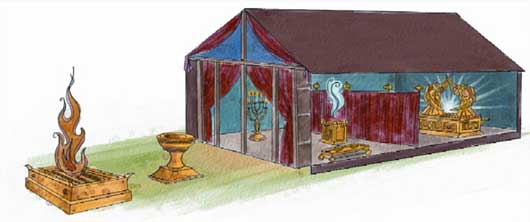
Courtyard
of the Sanctuary
In the courtyard in front of the sanctuary stood an altar made of brass
on which the priests offered sacrifices. Near it was a laver (basin) in
which they washed. The sanctuary itself consisted of two rooms, the Holy
Place and the Most Holy Place.
The
Holy Place
In the first room, or Holy Place, a seven-branched lamp burned continually.
It represented Jesus as the never-failing "light of the world" (John 8:12).
Near it stood a table on which loaves of bread (showbread) were placed.
This symbolized Jesus as the "bread of life" (John 6:35) who satisfies
our physical and spiritual hunger. Near the curtain dividing the two rooms
stood a golden altar of incense. The rising cloud of incense represented
prayers ascending to God.
The
Most Holy Place
The second room, or Most Holy Place, contained the "ark of the covenant."
This was simply a rectangular wooden chest covered with gold. But it symbolized
the throne of God. The lid of the chest was called the "mercy seat." This
represented God's loving kindness. Below the mercy seat and inside the
chest lay two tablets of stone. These were the tablets on which God had
written the Ten Commandments with His own finger. This symbolized the
fact that the commandments are to be a part of the lifestyle of those
who accept the Messiah into their lives. Two golden cherubim (representing
angelic beings) hovered over the mercy seat at each end of the ark.
A curtain (veil) hid
the Holy Place from the view of the people as the priests ministered to
them in the courtyard. A second curtain separated the Holy Place and Most
Holy Place.
The
Services of the Sanctuary
The Old Testament book of Leviticus describes in detail the services carried
on in the sanctuary. Those ceremonies were divided into two parts—the
daily services and the yearly services. In a typical daily service, someone
feeling guilty for a transgression would bring a sacrifice, such as a
lamb, to the temple as a sin offering. The individual would "lay his hand
on the head of the sin offering and kill the sin offering in the place
of the burnt offering." (Leviticus 4:29)
After the animal
was killed, the priest took the blood of the offering and placed some
of it on the horns of the altar of burnt offering (Leviticus 4:30). These
blood sacrifices conveyed the truth that sin results in death, that the
sinner can escape ultimate death only by having another person die in
his or her place.
Let's look at how
the heart of the daily sanctuary system focuses on the sacrifice of Jesus.
First, the animal brought for sacrifice had to be "without blemish" (Leviticus
1:3). That's because it represented Jesus as the holy, harmless, and undefiled
One (Hebrews 7:26). Second, the guilty person at the temple confessed
his sin and symbolically transferred his guilt to the guiltless animal.
This represents Jesus taking on our sins at Calvary. Jesus the "sinless
One" became "sin for us" (2 Corinthians 5:21). Third, the animal had to
be killed and its blood shed. Only in that graphic way could it point
forward to the supreme penalty that Jesus suffered on the cross. Jesus'
great saving act was represented over and over in the Old Testament sanctuary.
The yearly sacrifices
and ceremonies were concentrated on the High Priest's ministry in the
Most Holy Place, the second room of the sanctuary. In a sense, the yearly
sacrifices dealt with the accumulation of the daily sacrifices. As the
people came to confess their sins day after day, the blood of the sacrificed
animals was sprinkled on the corners of the altar (Leviticus 4:6-12).
Through these symbols the confessed sins of the people were being brought
into the sanctuary each day.
And so once a year,
on the Day of Atonement, the sanctuary itself was cleansed from all the
sins confessed during the past year (Leviticus 16). In this special ceremony
the High Priest sacrificed a goat. The High Priest carried the blood of
the goat into the Most Holy Place and sprinkled it in front of the ark
of the covenant. This was yet another symbol of the blood of Jesus, the
coming Redeemer, who would pay the penalty for sin. The High Priest then
ceremonially removed from the sanctuary all the confessed sins of the
previous year and placed them on the head of another goat which was led
out into the wilderness to die (Leviticus 16:20-22).
This yearly service
of the Day of Atonement cleansed the sanctuary from sin. The people regarded
it as a day of judgment because those who refused to confess and seek
forgiveness on this day were considered judged or cut off from God (Leviticus
23:29).
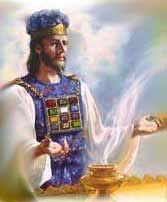 The
book of Hebrews compares what the High Priest did symbolically once
a year to what Jesus does once and for all. And it shows us why Christ
is a much superior High Priest in heaven. Jesus can offer complete forgiveness
at the moment we ask. And He can assure us that everyone who places
his faith in Him can have that assurance. During the investigative judgment,
when the books are opened and your name comes up, your record can state
that all your sins are forgiven. That's what Jesus can do as your High
Priest. He wants to save you for all eternity. He wants to blot out
the record of your sins forever. That's what He can do in the heavenly
sanctuary; He removes forever the confessed sins of all who have accepted
Him as Savior (Acts 3:19). The
book of Hebrews compares what the High Priest did symbolically once
a year to what Jesus does once and for all. And it shows us why Christ
is a much superior High Priest in heaven. Jesus can offer complete forgiveness
at the moment we ask. And He can assure us that everyone who places
his faith in Him can have that assurance. During the investigative judgment,
when the books are opened and your name comes up, your record can state
that all your sins are forgiven. That's what Jesus can do as your High
Priest. He wants to save you for all eternity. He wants to blot out
the record of your sins forever. That's what He can do in the heavenly
sanctuary; He removes forever the confessed sins of all who have accepted
Him as Savior (Acts 3:19).
What a fantastic plan
of salvation! God has placed it all there in symbols in the Bible for
you and me. The sanctuary expresses the heart of the Bible—the gospel
of Jesus Christ.
Now, let's go back
and look at Daniel and his reaction to the vision in chapter 8. Remember
that he was appalled about the "little horn" "trampling" the services
in the sanctuary (vs. 13). Now you can understand why. Daniel realized
that the "little horn" power was trying to interfere with God's wonderful
plan to forgive and save as symbolized in the sanctuary service. That's
serious business.
Looking at history,
we see that the Roman Church of the Dark Ages did indeed do the work symbolized
by the "little horn." The whole structure became a kind of "mechanical
Christianity" that blurred the pure gospel. A system of indulgences and
penance and rituals obscured the good news of forgiveness by grace alone.
Believers didn't feel they could go directly to Jesus for the free gift
of salvation. In place of simple faith in the substitutionary death of
Christ, complicated rituals were created as a means of earning merit.
All this was predicted
in the details of Daniel's "little horn" vision. The prophet could see
that here was a serious challenge to God's plan of salvation. No wonder
Daniel "fainted and was sick for days" and "was astonished by the vision"
(Daniel 8:27).
The
Lamb of God
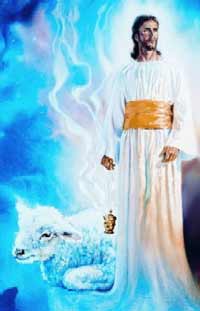 In
the sanctuary service there were sacrifices of rams, bulls, calves,
kids, doves, pigeons, and even a cereal offering. However, the lamb
was the main sacrifice; a lamb was offered on the altar twice a day.
The lamb is the best representation of Jesus as the ultimate sacrifice.
In fact, the New Testament refers to Jesus as "the Lamb of God." In
the sanctuary service there were sacrifices of rams, bulls, calves,
kids, doves, pigeons, and even a cereal offering. However, the lamb
was the main sacrifice; a lamb was offered on the altar twice a day.
The lamb is the best representation of Jesus as the ultimate sacrifice.
In fact, the New Testament refers to Jesus as "the Lamb of God."
- "Behold! The Lamb
of God who takes away the sin of the world" (John 1:29).
- "You were not redeemed
with corruptible things, like silver or gold, from your aimless conduct
received by tradition from your fathers, but with the precious blood
of Christ, as of a lamb without blemish and without spot" (1 Peter 1:18,
19).
Jesus is the spotless
Lamb of God! He loved you so much that He was willing to leave heaven
and come to Earth and die for you. He shed His blood to forgive your sins.
The Bible says, "The wages of sin is death" (Romans 6:23). Jesus had to
die in order for us to be forgiven. It cost the Son. It cost God the Father.
"He who did not spare His own Son, but delivered Him up for us all, how
shall He not with Him also freely give us all things?" (Romans 8:32).
What a fantastic promise!
God loves you and me. He gave us Jesus. "For God did not send His Son
into the world to condemn the world, but that the world through Him might
be saved" (John 3:17). God loves you so much that He is willing to do
whatever it takes to save you.
§ § §
During the Vietnam
War a Navy doctor and nurse found themselves trying desperately to save
an eight-year-old girl. She'd been critically wounded when a mortar round
hit her orphanage. The child needed a transfusion immediately. They tried
to explain the situation to the other orphans. The girl would die without
blood. Would anyone be willing to help?
The children stared
back, very frightened. Finally a boy named Heng raised a trembling hand.
The nurse quickly thanked him and swabbed his arm. As the blood was being
drawn Heng clamped a fist over his mouth—trying to stifle his sobs.
But when the nurse asked him if it was hurting, he shook his head no.
Still, something was clearly wrong.
Fortunately, a Vietnamese
nurse arrived and began talking to the boy. After a while she explained,
"He thought he was going to die. He thought you'd asked him to give all
his blood so the little girl could live." The Americans were astounded
and humbled. The American nurse just had to know. "Why would he do that?"
The Vietnamese nurse relayed back the boy's simple answer: "She's my friend."
That's what a little
Vietnamese boy was willing to do for a friend. That's what the Son of
God really did for you. He really did give all His blood. He really did
die in your place. He did that because He cherishes you as a friend, and
He longs to give you the assurance of living eternally face-to-face with
God. What would you like to say to Jesus today?
—
Prayer —
Father, thank
You for going to such lengths to help me understand the sacrifice of Jesus
and Your gift. Thank You for the plan of salvation and the free gift of
forgiveness and eternal life in Jesus Christ. I accept Your pardon for
my sins and shortcomings. Thank You in the name of Jesus. Amen.
|